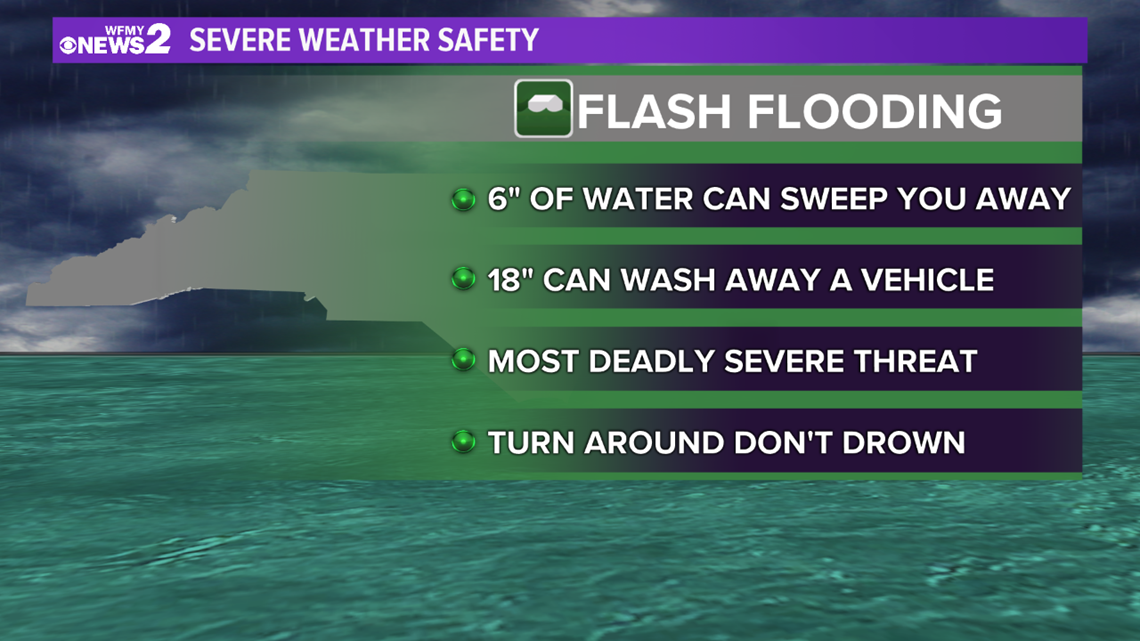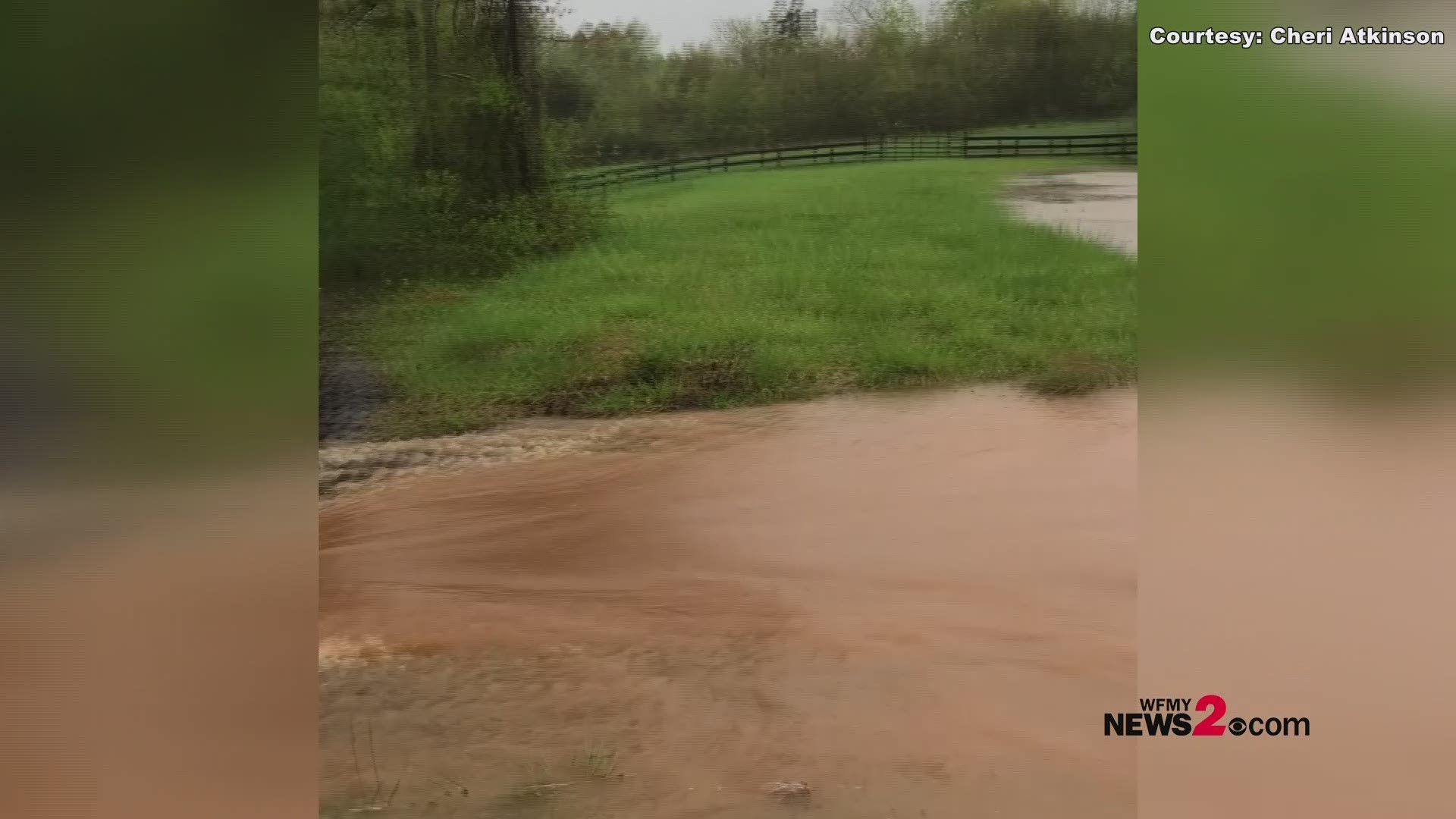GREENSBORO, N.C. — Flash flooding is the number one storm-related killer in the United States, according to the National Weather Service.
FLASH FLOODING KILLS
At least 127 people die each year due to flash flooding. Why so many deaths? Often times, people think they can drive safely through a flooded road then realize they can’t which can become too late.


It takes just six inches of water to make it more difficult to control your vehicle. A vehicle can be swept away in 18 to 24 inches of water. That’s why you’ll hear so many times, “TURN AROUND, DON’T DROWN!”
WHAT IS FLASH FLOODING?
A flash flood is a rapid rise of water along a stream or in a low-lying urban area. Flash flooding can result from slow-moving thunderstorms, from numerous thunderstorms which develop repeatedly over the same area, or from heavy rains associated with tropical cyclones. These floods may develop within minutes, depending on the intensity of the rainfall, the topography, soil conditions, and ground cover, according to the National Weather Service.
(Video captured in 2018 of flooding in the Piedmont Triad)
FLOODING SAFETY TIPS
- Remember to TURN AROUND, DON’T DROWN!
- If told to evacuate, do so immediately. Never drive around barricades. Local responders use them to safely direct traffic out of flooded areas.
- If your vehicle is trapped in rapidly moving water, then stay inside. If water is rising inside the vehicle, then seek refuge on the roof.
- If trapped in a building, then go to its highest level. Do not climb into a closed attic. You may become trapped by rising floodwater. Go on the roof only if necessary. Once there, then signal for help.
- Stay away from high water, storm drains, ditches, ravines, or culverts.
- 12 inches of water can carry away a small car.
- 18 inches of water can wash away a vehicle.
- More than half of ALL flood-related drownings occur when a vehicle is driven into floodwaters.
- Many flash flood deaths occur at night.
- 6 inches of fast-moving water can knock you off your feet.
- It takes only 2 feet of water to float away most vehicles.
- Never walk through floodwaters.
- If you’re trapped by moving water move to the highest point and call 911.
- If line markings on the road are not visible, DO NOT drive through the water.
- Avoid driving through pools of standing water.
- Purchase or renew a flood insurance policy. It typically takes up to 30 days for a policy to go into effect and can protect the life you've built. Homeowner’s policies do not cover flooding. Get flood coverage under the National Flood Insurance Program (NFIP)
KNOW YOUR FLOOD RISK
You can find out the types of flood risk for your area by checking out the following:
- Know types of flood risk in your area. Visit FEMA’s Flood Map Service Center for information.
- Check out: NC Flood Maps
WEATHER ALERTS, EMERGENCY NEWS APPS
Make sure you download the WFMY News 2 App, and the WFMY News 2 Weather App for the latest news emergency information.
DOWNLOAD NOW: WFMY News 2 App: Apple Users, Android Users
WFMY News 2 Radar App: Apple Users, Android Users
If the power or cable goes out, you'll still be able to connect online. Download the WFMY News 2 App for live streaming video, updated weather forecasts, and reports from our field crews. Be sure to check the county where you live and work, so you'll get alerts in your area. You can also get alerts for other locations.
CHARGE IT UP
Charge Up Your Tech Devices: With severe weather, there's always the possibility of power outages. Plan ahead and get your phones, laptops, and tablets charged up now. The more options you have when the power goes out, the longer you'll be able to keep in touch.
TWITTER VS. FACEBOOK FOR WEATHER UPDATES
Twitter vs. Facebook: Don't depend solely on Facebook to deliver timely weather alerts. Facebook uses an algorithm to determine what shows up in your newsfeed. Every post does not show up in your feed even if you've liked a page. You will miss important posts if you only depend on seeing them through Facebook. Twitter, on the other hand, will show every single post from a source you're following. Be sure to double-check timestamps on tweets.
SHARING YOUR PICS. AND VIDEOS
Join the WFMY News 2 Team: When it's safe (and ONLY when it's safe!), your reports help us see what's happening in every corner of our coverage area. Send photos and videos to myphotos@wfmy.com or webteam@wfmy.com
Also, post pictures on the WFMY News 2's Facebook page plus like the page for updates and tag us on your Twitter Post @WFMY using #STORMTRACK2
You can also text WFMY News 2 your photos and videos to 336-379-5775. Make sure to include your name and location.
REPORTING POWER OUTAGES
Duke Energy: 1-800-POWERON, 1-800-769-3766 Customers may also report an outage or view current outages online
Duke Energy Progress: 1-800-419-6356
NC Electrical Cooperatives: 1-888-411-7870
Energy United: 1-800-386-4833
Randolph Electric: 1-877-736-2633
Piedmont Electric: 1-800-449-2667
Surry-Yadkin Electric: 336-356-8241
City of Lexington Electric: 336-248-2337
City of High Point Electric: 336-883-3111
FOLLOW US ON TWITTER
@WFMYWeather
@WFMY
@TimBuckleyWx
@tkweather
@CKMorganWX
@EdMatthews2
@EricChilton
Stay connected to local, national and breaking news: Download the new WFMY News 2 app.
►Text the word APP to 336-379-5775
►For the latest weather conditions and forecast text the word WEATHER to 336-379-5775
►For traffic alerts text the word TRAFFIC to 336-379-5775

